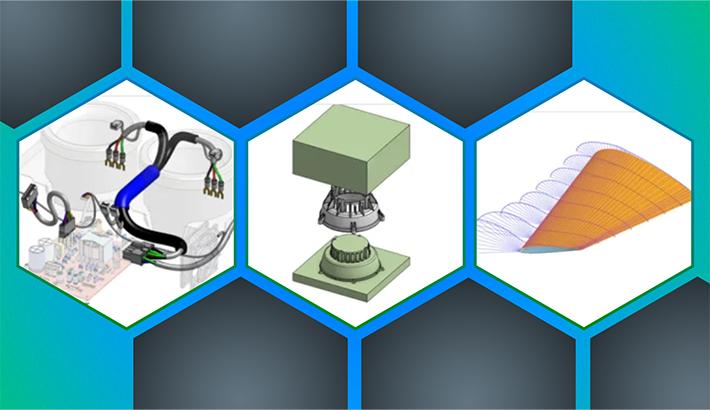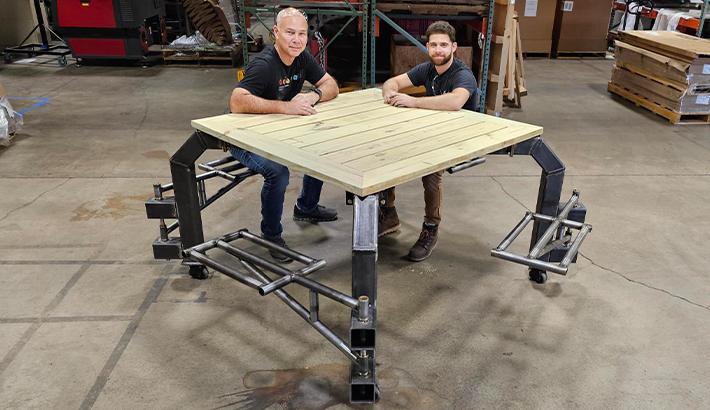
6:40
How do you stop airborne pathogens from infecting precious grapevines that will turn into wine?
The team at Root Applied Sciences is here to stop that. The Bay Area startup, a member of the Onshape Startup Program, has discovered a better way to detect fungus and protect grape farmers from crop loss, and wasted time and money on unnecessary fungicide sprays.
An Idea Takes Root, then Flourishes
A Root sensor stands in a vineyard.
(Courtesy: Root Applied Sciences)

Root CEO and founder Sarah Placella’s background is in environmental sciences, having studied at Johns Hopkins University; the University of California, Berkeley; Michigan State at Kellogg Biological Station; and at INRAE in France.
When asked to apply for faculty jobs, she realized she didn't want one.
“I decided that, hey, all these years doing research, I can actually apply that to help people more immediately. I realized that this was important to me and I had to do some soul-searching. And I decided that I should look at a different career path,” she said.
“I was really eager to see impact sooner in my lifetime.”
Jumping into the startup world had its own challenges. With no engineering experience, Placella had to find resources that could lead her down the right path.
With help from the CITRIS Foundry, a Bay Area accelerator program, she was connected to prototyping tools and to engineers with the expertise needed to design and create the first edition of a Root sensor.
Now her team of six is working on redesigning the units and improving the automated system.
“We can't be wrong – we are talking about people trusting us with their crops,” she said. “We have to not only make an automated system, but then we're going to take a lot of time refining it and making sure that it's super robust, and every time we have something manufactured, we are going to have to do testing to make sure that it's meeting our requirements for reproducibility.”
Detecting Infection Threats is an Inexact Science
Sarah Placella with Rafael Llamas of ZD Wines.
(Courtesy: Root Applied Sciences)

For vineyards and grape farmers, powdery mildew is a monumental concern that can devastate acres of crops. Powdery mildew is a fungal disease that can ruin the crop. Its spores are spread by wind.
In California, farmers rely on fungicides to protect their crops, but the amount and timing of sprays are based on factors other than the mildew itself.
Typically, farmers plan sprays according to the Powdery Mildew Risk Index (PMI), which is based on environmental conditions that support fungal growth, such as wind, heat, and humidity. However, with too many sprays, crops are at risk of becoming resistant to the fungicide used.
Placella heard the problem firsthand from a winemaker in the Livermore Valley.
“‘My real problem is powdery mildew,’” the winemaker told her. “‘I spray 17 times a season and I know that I have fungicide resistance problems because I spray too much, but I can't see the pathogen in the air. But if I don't spray, I'm going to lose my crop.’”
Placella was intrigued.
“Well, you can't know what's in the air, but I can,” she said. “And that took me down this path of airborne pathogen monitoring for farmers.”
Root Applied Sciences is an Exact Science Solution
Root devices ready for monitoring. (Courtesy: Root Applied Sciences)

Placella spent years studying the environment and microbes. She knew there was another way to detect powdery mildew that is more efficient and accurate than the PMI.
“The issue is it has to be a DNA-based approach,” Placella explained. “We have to be able to quantify the DNA to know how many spores are in the air.”
She founded Root Applied Sciences, which makes a sensor that is placed throughout a vineyard to collect and monitor spores floating in the air. Each sensor can cover up to 10 acres of grapes, depending on landscape features like hills and valleys. The sensor can detect powdery mildew based on its DNA, and can then alert farmers if they’re at risk of an infestation within 10 days.
Early results from a pilot program in 2021 showed that one grower reduced pesticide application by 70 percent, the same year the PMI indicated a high infestation risk.
“Environmental conditions may have been correct, but there was no pathogen around,” Placella said. “All of those sprays would have been unnecessary because the pathogen was not around.”
Then in 2022, the opposite happened. The PMI was very low but Root’s sensors detected spores in the air, prompting farmers to watch out for a fungal spread. With that information, “Our growers ended up spraying early and being vigilant and, ultimately, still saving sprays,” she said.
In addition to saving time and money from unnecessary pesticide sprays, Root’s solution has surprising benefits to farmers and the world.
In one survey, growers told the Root team one of the biggest benefits of the technology is worker health.
“Nobody wants to spray pesticides. They know that they're bad for the environment,” she said.
Plus, her team found that if every grape grower in the world used Root’s technology, “We would save five and a half megatons of carbon dioxide equivalents just from reducing the spraying.”
Better Workflows Powered by the Onshape Startup Program
Root’s Mechatronics Engineer Victor Suttabongoch and Fluidics Engineer Alex Schmidt.
(Courtesy: Root Applied Sciences)

“We know that it's a lot of work to iterate over that automated system to make it reliable, reproducible, manufacturable, and have the product that comes out be something that's going to work all the time,” Placella said. Anything that helps the engineers out can only do good.
This is where the Onshape Startup Program comes in handy for the team. Through the program, Root’s engineers are set up with Onshape Professional accounts at no cost.
“I love Onshape,” said Bar Smith, a Root engineer. “Just having all your files, all the time saved and having versions of everything and being able to share them totally effortlessly. We don't really even think about who has what files – everyone has access, which is awesome.”
From Onshape’s sketching and assembly tools to the Onshape community, Root’s engineers are able to leverage cloud-native technology and build better products quicker.
“Onshape allows us to effortlessly access our CAD files from any computer. It has an easy-to-use interface, all the right features, and great customer service. Fluidics Engineer Alex Schmidt said. “This is, without doubt, the future of CAD, available here and now. I am excited to continue using Onshape to create simple solutions for our complex problems.”
“Now that I have [all the design data] in Onshape, it's so much easier to go back up to previous designs or previous drawings and use that information,” Junior Engineer Jess Simon-Parker said. “It's been really helpful in designing and I think it's saved me a lot of hours, days, probably, of time to just model things.”
“I feel like we live in a really exciting time for engineering in terms of collaboration and rapidly getting to learn from things,” Smith said. “With CAD software and 3D printing, you can just go so quickly from having an idea to working on it collaboratively, to making a physical thing and holding it and seeing how it feels in the real world.”
An AgTech Disruptor
In the real world, more and more farmers are using Root’s technology. In 2021, Root had 13 units up and running. In 2022, that number jumped to 89 and increasing every year, with growers joining all along Northern California from Salinas Valley up through Napa and Sonoma.
Root also just released version 2.0, featuring updated units that make the device look better and work more efficiently for users.
As for the future, Root’s technology has the potential to impact more than grapevines. Since it can analyze anything with DNA, growers can protect crops from spores that can infect spinach, lettuce, canola, wheat, apples, cherries, and more.
The Onshape Startup Program
Equip your team with full-featured CAD, built-in PDM, and real-time collaboration in one system.
Latest Content

- Case Study
- Consumer Products
BOA Technology: Redefining Outdoor Fit Equipment with Cloud-Native Onshape
11.03.2025 learn more
- Blog
- Evaluating Onshape
- Custom Features
Accelerated Product Development with Next Generation CAD Automation
01.15.2026 learn more

- Blog
- Collaboration
- Education
- Enterprise
- Customers & Case Studies
From Concept to Real-Life Impact: Building a First-of-Its-Kind Inclusive Picnic Table
01.09.2026 learn more



